The Red Shoes, 1948, directed by Michael Powell and Emeric Pressburger, screenplay by Michael Powell and Emeric Pressburger, additional dialogue by Keith Winter.
Brian Eno famously observed that only 100 people bought the Velvet Underground's first album when it was originally released, but they all started bands. The Red Shoes may well be the cinematic equivalent. Over the years, The Red Shoes has inspired albums, installation art, choreography, and the careers of countless ballerinas. Pretty much all of the great MGM musicals of the fifties owe it more than a little. It's one of Martin Scorcese's all time favorite movies, and he credits it with providing the breakthrough he needed to figure out how to film the fight scenes in Raging Bull. But unfortunately, Powell and Pressburger are also responsible for Snake Eyes, Mission to Mars, and The Bonfire of the Vanities, since The Red Shoes convinced Brian De Palma to become a filmmaker.
It's clear why creative people of all types would turn to The Red Shoes for inspiration; the movie is about the level of personal sacrifice and dedication practicing any art at a high level requires. The movie follows the lives of two young people as they get their start in the world of ballet. Moira Shearer plays Victoria Page, the ballerina:
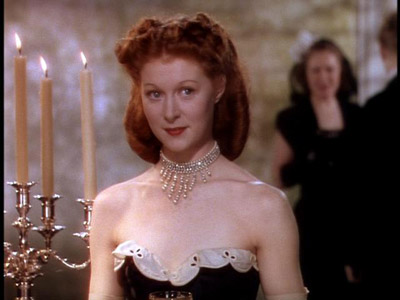
And Marius Goring plays a young composer named Julian Craster:
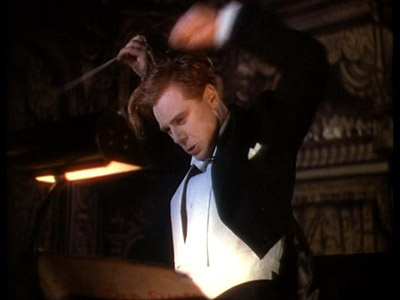
Both Victoria Page and Julian Craster join the Ballet Lermontov, a touring Russian company modeled on Diaghelev's Ballet Russes, and fall to different degrees under the sway of Boris Lermontov, the diabolical impressario who runs the ballet. As you can see from the stills, the movie is not what you would call down to earth in terms of its costumes or settings; it's set among the highest of the upper class. Believe it or not, Page and Craster are the closest the movie gets to working class characters; Anton Walbrook's portrayal of Boris Lermontov will go down in history as the definitive European aristocrat. Here he is early in the film and early in the morning, smoking a cigarette and reading his mail:
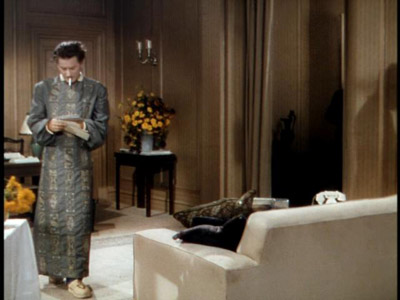
Yes, that's a tartar robe he's wearing. In a few seconds, he's going to hold out that cigarette until his butler appears from nowhere, takes it from his hand and extinguishes it; walking to the ashtray himself would be too, too exhausting. And here he is taking a stroll with other members of his company on the streets of Monte-Carlo, wearing exquisitely bizarro sunglasses:
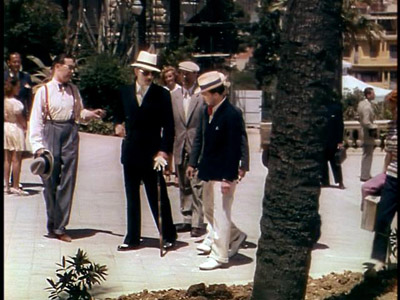
Lermontov is a bully, he's arrogant, he's jealous, he's manipulative, and he cares for nothing but his ballet. As a result, he's able to extract brilliant work from everyone who works for him. Craster and Page join the Ballet Lermontov at the same time (in fact, on the same morning), and the early part of the movie follows them as Lermontov carefully cultivates their talents. They both get their big chance at the same time, too: Lermontov asks Victoria Page to dance the lead in a new ballet that Craster is writing. The subject is "The Red Shoes," and here's how Lermontov describes the story to Craster:
"The Ballet of The Red Shoes" is from a fairy tale by Hans Andersen. It is the story of a young girl who is devoured with an ambition to attend a dance in a pair of red shoes. She gets the shoes and goes to the dance. For a time, all goes well and she is very happy. At the end of the evening she is tired and wants to go home, but the red shoes are not tired. In fact, the red shoes are never tired. They dance her out into the street, they dance her over the mountains and valleys, through fields and forests, through night and day. Time rushes by, love rushes by, life rushes by. But the red shoes go on.
Craster asks, "What happens at the end?" and Lermontov carelessly replies, "Oh, in the end she dies." The careful reader will guess that there are some similarities between the story and Victoria Page's. The movie is, in fact, about the way art consumes life. Lermontov, while not an artist himself, understands this better than Page or Craster; it's the source of his power over them. He has no understanding and even less interest in what he calls "the doubtful comforts of human love," so his reaction on hearing that Craster and Page are seeing each other must be seen to be believed. He finds out at the birthday party of his head choreographer; here's his reaction shot, surrounded by people having a good time:
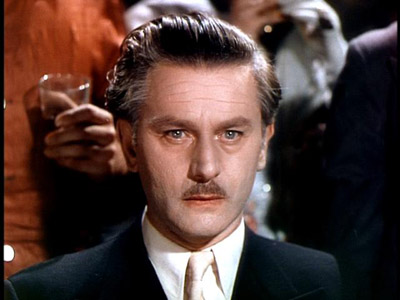
The life of the party.
And later, when he discovers they've just been married:
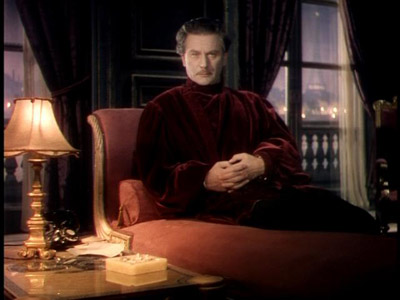
Note the full ashtray next to him and that unbelievable Russian velvet shirt. When you break out the red velvet, you know it's been a long, dark night of the soul. He's not conventionally jealous, however: he simply thinks Victoria Page can't be a great dancer if she allows herself to spend any time on normal life.
As you can see from the costumes, nothing in this movie is played subtly. Moira Shearer, on first reading the script, thought it was "simply awful. Pure women's magazine," and in its bare outlines she was right. But Powell and Pressburger take so many risks throughout that you're inclined to forgive them their more baroque conceits. The biggest risk by far is the Ballet of the Red Shoes itself, which is the centerpiece of the movie, and an actual ballet, albeit a short one, created for the movie by Brian Easdale and choreographed by Robert Helpmann.
Most movies about artists of any type make one of two mistakes. If the movie is about an actual artist (e.g., Pollock), then the art itself is liable to be good. To counter that, most filmmakers succumb to an irresistable urge to come up with a ridiculous story about how the artist got their ideas. If the artist is fictional, the art itself tends to be, shall we say, not as good as the other characters would have you believe. Powell and Pressburger avoided both of these pitfalls here. The scenes of Craster working on the score have a ring of truth to them that is usually missing from this kind of movie; watch for a scene in which he excitedly explains to Lermontov that the church scene should use a four-part chorale, and then bangs out on the piano how he'd like it orchestrated. And although I'm no balletomane, the ballet itself seemed quite passable to me.
Which is a good thing, because rather than showing excerpts from Victoria Page's big performance, Powell and Pressburger show you the whole ballet, start to finish. This is a fifteen minute sequence right in the middle of a conventional melodrama, and it could have brought the movie to a screeching halt. It works, though, and is actually necessary for the rest of the film to make sense.
First, it's a cinematic ballet, not a theatrical one. The first shots of the ballet are done from the audience's perspective, but the camera quickly moves onto the stage. Within the first minute, Victora Page sees the red shoes on display in the shoemaker's shop and imagines herself dancing in them. We see what she sees, thanks to the miracle of optical printing:
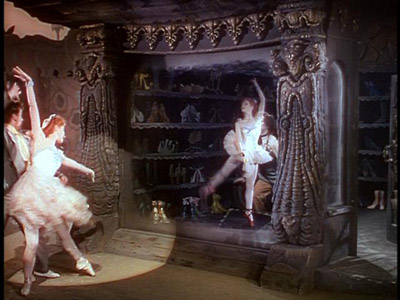
This is an effect that would be difficult to produce on stage, to put it mildly. From that point on, the ballet is completely cinematic. It uses optical shots, jump cuts, variable camera speed and other special effects of all sorts to make the first film ballet (as opposed to filmed ballet). "The Red Shoes Ballet" is bold gesture after bold gesture, and enough of them work that it's difficult to fault the ones that don't. There are parts that didn't work for me; the line of dancers that transform into flowers, birds, and clouds, for example. But it's like watching a standup comic—not all the jokes hit but as long as they keep coming, it's all right. For me, the single best shot in this sequence comes at the end of the fair. All the other dancers are dropping from exhaustion, but Victoria Page keeps dancing. The camera follows her down an alley as cellophane posters drift to the ground. It's a tracking shot, and couldn't happen on stage, but on film it's haunting.
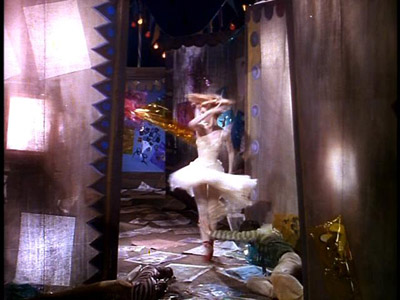
Even more importantly, the Red Shoes Ballet is subjective. Rather than trying to capture the experience of a hypothetical audience member, Powell and Pressburger try to capture on film Victoria Page's experience dancing. Take a look at this still from the pas de deux:
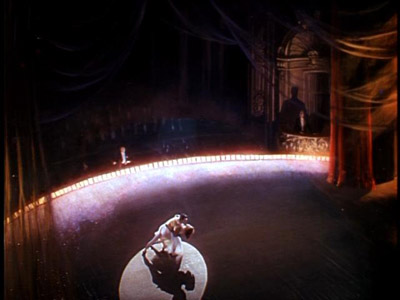
It's one of the only shots we get of the audience, and as you can see, they're not particularly important to Page. She's dancing for two people: Craster (conducting) and Lermontov (in the box). As I said earlier, Scorcese learned how to shoot the fight scenes in Raging Bull from studying this sequence. Like Powell and Pressburger, he stays mostly in the ring, focuses on La Motta's subjective experience (think of the zoom in/dolly out shot during the last Sugar Ray Robinson fight). He treats the audience the same way Powell and Pressburger do, too:
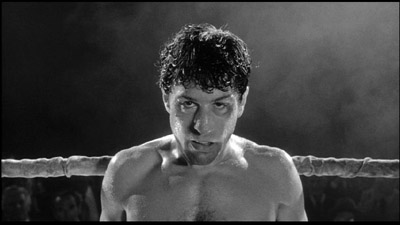
La Motta doesn't give a fuck about them, so they fade into the background. She wouldn't put it that way, but Victoria Page feels the same way. Even when they begin applauding before she's finished dancing, she doesn't process it as applause. In the soundtrack we hear applause but here's what we see:
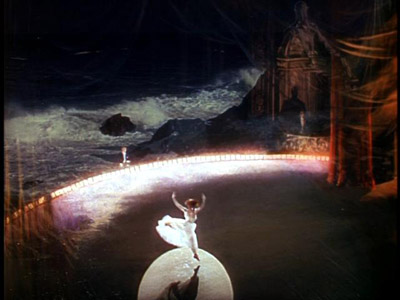
Filming the ballet subjectively is incredibly important for what follows. For the audience to understand why choosing between life and art is near-impossible for Victoria Page, it has to be clear what she gets from ballet. She says, early in the movie, that asking her why she wants to dance is like asking someone else why they want to live. By the time the ballet sequence is over, you understand what it's like for her to be on stage, and it's very clear that when she is forced to choose between art and "the doubtful comforts of human love," she'll choose art every time.
Randoms:
- This disc has one of the strangest commentary tracks I've ever heard. In the seventies, Powell and Pressburger co-wrote a novelization of the movie for Avon Books; there's a complete audio track of Jeremy Irons, no less, reading from this novelization. There's a similar track on Lord of the Flies, but it's Golding reading from his own novel on which the film was based, not a book based on the movie published thirty years after the fact. Not surprisingly, the book is not as good as the movie; nobody watches The Red Shoes for the screenplay.
- And speaking of embarassing collaborations between Powell and Pressburger in the 1970s, the last film they made together is featured in the (excellent) filmography on the DVD. It's The Boy Who Turned Yellow, an educational film about electricity. Besides the novel and this movie, their collaboration ended in 1957.
- Moira Shearer is interviewed on the disc. At the time the film was made, she was a world class ballerina at the top of her game. The same could not be said, however, for Robert Helpmann or Léonide Massine, the two other featured dancers. Massine had been world-class; in fact, he was the one cast member who danced in Diagilev's Ballet Russes. At the time The Red Shoes was made, however, he was in his early fifties and well past his prime. Helpmann was younger, but was never as good a dancer (I recognized him from Henry V, where he played the Bishop of Ely). Shearer wastes no time in pointing out that neither man is a very good dancer in the film, although she does allow that "Bobby's" choreography is "perfectly adequate." She sounds like she might have not been much fun to work with. Apparently she and Michael Powell grew to hate each other over the course of the film. She does seem to have nothing but respect for Anton Walbrook, however.
- The locations in the film are great; they really used Covent Garden and the Mercury Theater in Notting Hill. The best, however, is a brief scene inside the Opéra National de Paris. Check out this room:
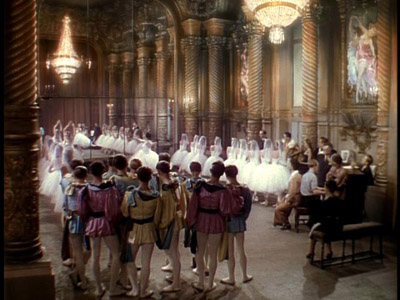
- Posh.
- Everyone who writes about this film mentions the color, so: it's lush. According to the founders of Technicolor, this is the best example of three-strip Technicolor there is. As you no doubt know, three-strip takes incredible amounts of light, which means that the shots during the ballet that featured a spotlight (see the stills above) were very difficult to create. Because the non-spotlit areas were already so brightly lit, an unbelievably bright light had to be built to create the circular outline of a spotlight. It was designed specifically for this production and, unlike every other light I've ever heard of, was water-cooled.


14 comments:
Yeah, man, it's well worth watching. Just be prepared for over-the-top melodrama. My holidays have been great, and I hope yours have been too; I've been enjoying your blog.
oh yeah, also in the royal tenenbaums, the title sequence (and other shots in it) is an homage to the red shoes according to wes anderson himself.
I wondered about that -- actually, the opening credits in "The Most Dangerous Game" also reminded me a little bit of "Tenenbaums" (the shot of the credits between two burning candles). It will be interesting to see that movie again now that I've seen "The Red Shoes." Just 110 movies between me and "The Royal Tenenbaums" now...
Matthew: Thanks for reviewing all these movies. Your review here spurred me to find and watch The Red Shoes. It was thoroughly enjoyable -- a fairy tale with fabulous locations.
Steve, glad you liked it. This whole project has been about me watching movies I wouldn't have ordinarily sought out, so it's good to hear that these essays are having the same effect on other people.
My all time favorite movie!
You didn't mention all the other extras, or not in detail. Yes, you can watch the film straight, or you can watch it with a commentary track by Prof. Ian Christie (author of many books about Powell & Pressburger) who interviews many of the surviving cast & crew like Moira Shearer, Marius Goring, cinematographer Jack Cardiff, composer Brian Easdale and Martin Scorsese. Or you can watch the film as you listen to the third audio track with Jeremy Irons reading from Powell and Pressburger's novelisation of The Red Shoes.
You can look at Martin Scorsese's collection of The Red Shoes memorabilia. Or you can look at a collection of rare publicity of behind-the-scenes production stills.
You can view The Red Shoes Sketches, an animated film of Hein Heckroth's painted stoyboards. These may be viewed by themselves or in split screen (alternate angle) with the ballet of "The Red Shoes" from the film. The animated film may be viewed with the music from the ballet or with Jeremy Irons reading from the original Hans Christian Anderson fairy tale.
And you can see a Powell and Pressburger filmography with film clips and stills.
That's a LOT of extras, even for a Criterion release.
Oh, and there's now a new print been made of the film. Scorsese's Film Foundation and others worked on it for many years, going right back to the original negatives. And it's even more fabulous than the print on this Criterion release. The new print was shown at Cannes 2009.
http://www.powell-pressburger.org/Trips/Cannes/20090515/index.html Steve
Why did you mention only mediocre De Palma films? These cheap jabs do not make your review smarter.
Thanks for your insights. In the next few days I'll be writing about The Red Shoes in my own blog, and I'll be focusing the discussion around the colors. Good to know about that difficult lighting arrangement in the stage scene, which was one of the best uses of compositing and composition I've seen in a classic film.
It was a beautiful, romantic film, and now I'm suddenly interested in Powell's move into darker territory, from Black Narcissus to The Red Shoes to Peeping Tom.
Again, thanks for your insights.
Great review! I just saw a 35mm print of this at the Cleveland Cinematheque, and must say that three strip Technicolor process really holds up, just gorgeous.
I remember seeing this movie when I was 8, and hated it. Certain scenes stuck with me though (the ending especially) and peaked my interest enough to go check it out again 13 years later.
I didn't realize how much this movie sucks you in until the moment right before The Ballet of The Red Shoes begins. For those few seconds between when Julian raises his hands and the curtain opens, you could hear a collective gasp from the audience, and then dead silence. My girlfriend grabbed my arm and grabbed it tight. I could feel my chest tighten like I was getting choked up. It's moments like that, halfway through the film no less!, that make you realize the brilliance of what's being delivered.
Thanks for these reviews! There consistently entertaining and educational.
My sister was a dancer, and this movie was our family's favorite. She loved the dancing, I loved the music. One month before she passed away, I was considering buying an autographed copy of Dame Margot Fonteyn's autobiography. The inscription read, "To Moira Shearer..."
Quite worthwhile info, thank you for the article.
where is Costa Rica | orange jumpsuit | counter height
I feel like such philistine saying this, but did I love The Red Shoes? Not so much. I loved the lush color, in fact never tired of re-watching this because of it. Great color always moves me (i.e. Michael Curtiz’s The Adventures of Robin Hood), even if the film has other problems (Pleasantville). And I loved the posh settings. But for The Red Shoes to succeed dramatically, Victoria Page’s dilemma of choosing between her art and her love must draw you in. Unfortunately Victoria’s choice is nowhere near as compelling as Sophie’s.
Victoria Page comes across as self-absorbed and a bit of a snob. Since I don’t care that much about her happiness, her death doesn’t strike me as the tragedy it’s supposed to be. And without being unnecessarily cruel, Marius Goring as Julian Craster, the “love” part of this equation, let’s just say he’s no Cary Grant (or Tyrone Power or Bogie or Gable or Redford or Newman or Hudson…you get my drift). It doesn’t help matters that the love story seems tacked on with little foreshadowing (or chemistry) about two-thirds of the way through the film. By far the most successful characterization is Anton Walbrook’s Boris Lermontov, so successful in fact that it seems to me there’s no real choice here…it’s art all the way.
The Red Shoes Ballet stands up well. Powell and Pressburger and Clayton’s innovative cinematography and heavy reliance on editing seem very modern. Compare this to another dance film of 1948, Easter Parade. Astaire’s routine in “Stepping Out With My Baby” is about five minutes long and contains about six shots, almost all of them straight on shots of Astaire framed head to toe. Any random minute of The Red Shoes Ballet contains at least that many shots (and sometimes many more), and those shots vary greatly in composition and execution (shots from above, extreme long shots, extreme close-ups, tight shots of the red shoes, slow motion clips, jump cuts, etc.) Even in the MGM musicals clearly inspired by The Red Shoes, the extended ballets are shot in a very conventional manner. It isn’t until Bob Fosse’s work on Sweet Charity and Cabaret that we again see anything close to a modern approach to dance on film.
Have been head over heels for The Red Shoes since first seeing it some decades ago, ironically, 'on a rainy Saturday afternoon' during a PBS pledge drive. My sentiments, being a widower, run more toward the poignant as I age noting the tragic inevitability of the film's denouement. However, as Miss Page shines during the gloriously detailed performance of The Play within The Film I can't help but hope she realizes her evolving dreams.
Post a Comment